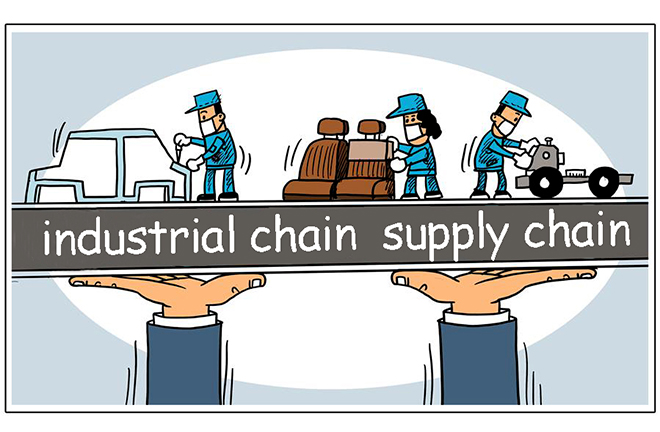Global industrial chain and supply chain evolve with time

Workers busy in the industrial chain and supply chain Cartoon: Zhu Huiqing/XINHUA
With major changes in the international market environment, the free flow of a series of factors of production is blocked, which greatly damages the stability of the global industrial chain and supply chain. According to the latest World Economic Outlook: A long and Difficult Ascent issued by the International Monetary Fund (IMF), the global economy will shrink by 4.4% in 2020. Meanwhile, the Chinese economy is projected to grow by about 1.9%, making it the only major economy in the world that achieved positive growth.
The COVID-19 pandemic has had serious impacts on the global economy, and its ascent back to pre-pandemic levels will take a long time, and remains prone to setbacks. To effectively prevent and control the pandemic, some countries have gradually changed from adopting one-way restrictive means to two-way and multilateral strict control measures, which directly causes the great risk that the overall global industrial chain and supply chain may fracture.
It was proposed in the Fifth Plenary Session of the 19th Central Committee of the Communist Party of China that the modernization level of the industrial chain and supply chain should be improved. Faced with the challenges of global uncertainties and risks, China should actively make correspondent adjustments to ensure that its economy adapts to the situation and achieves growth.
Division of labor is one of the main ways through which transnational corporations from developed countries seek globalization. As a developing country, China adopted OEM (Original Equipment Manufacturer) services early in the process of globalization—using the comparative advantage of factors of production which are cheap at relatively low levels of the industrial chain and the supply chain. By relying on this development mode, China started from the most primary stage of assembly and processing and followed the "export-oriented" principle.
After years of development, China gradually became embedded into the global value chain system and became a "world factory," as its manufacturing industry transformed from weak to strong. In this process, the development of its industrial chain continued to deepen and the industrial structure continued to upgrade. The efficiency of its supply chain also continued to improve. With stronger core competitiveness in the two chains, China enjoyed a constantly ascending status in the global industrial chain and supply chain, which provides a firm basis for the Chinese economy’s long-term steady development and its resistance to external risks.
In the process of globalization, transnational companies distribute a product's different production links around the globe according to its location and cost advantages, which leads to the international flow of a large amount of intermediate products, trade, and elements. This process is always accompanied by the shaping and transformation of the industrial chain and the supply chain. In fact, the COVID-19 pandemic is only an external factor that leads to global uncertainty and risk, and the central-peripheral approach to the division of labor system is the biggest internal factor of uncertainty. Developing countries need to gradually eliminate the trap of division of labor under the lock-in effect exerted by developed countries.
On one hand, transnational corporations from developed countries try to establish a stable industrial chain and supply chain system dominated by developed countries by virtue of their capital advantages. In constantly constructing global value systems, these corporations make the industrial chain and the supply chain the carriers of their global strategic intent and core competitiveness, which has produced a lock-in effect on emerging countries in a subjective sense. On the other hand, developing countries are easily too heavily reliant on the OEM mode, which they adopted a long time ago. Most corporations from these countries integrate into the global industrial chain and supply chain through OEM, while ignoring such procedures as research and development, design, and marketing services. The corporations become the appendages which reactively wait for production orders. This also produces its own lock-in effect in an objective sense. Once developing countries decide to stop this kind of effect, transnational companies will curb OEMs from imitating and catching up by means of anti-dumping, technical barriers, patents and intellectual property rights. As a result, the independent innovative ability of OEMs will be inhibited.
At the same time, the new round of scientific, technological revolution and industrial reform have also brought new impacts to economic development. The manufacturing industry's transformation towards digitized, networked, and intelligent trends is accelerating. At the same time, there are still obvious deficiencies in the Chinese industrial chain and supply chain. In particular, the supply of high-end products in the supply chain is insufficient, and the digitization level of these two chains in China needs to be improved.
The Chinese economy has shifted from a stage of high-speed growth to a stage of high-quality development. One of the characteristics of this new stage of development is to end processing and export of products with low added value, expand domestic demand, and cultivate China's new advantages in international cooperation under the new situation. The current global uncertainty and risk is not only a test but also an opportunity. China needs to keep improving the way that it creates, elevates, and acquires values in pursuing high-quality development, so as to finally realize the sustainable goal of building "a community of shared future for mankind."
Song Xianping is a professor from the School of Humanities and Social Sciences at Beijing Institute of Technology.
Edited by BAI LE
